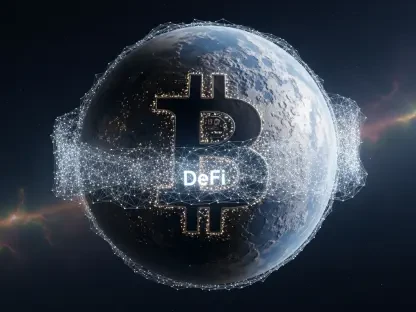In the rapidly evolving landscape of digital finance, blockchain platforms are transitioning from niche technology to integral components of global capital markets. Often referred to as the “re-platforming of capital markets,” this transition is gaining momentum as blockchain platforms like Ethereum and Solana offer advancements that Bitcoin, despite its foundational role, cannot match. The growing adoption of decentralized finance (DeFi) applications such as real-time payments and lending underscores Bitcoin’s limitations in these areas. With over $24 billion in assets already tokenized on public blockchains, influential entities like J.P. Morgan and Siemens are signaling a significant market transformation. This shift could reshape the financial sector, emphasizing programmability, transaction speed, and reduced costs.
The Rise of Programmable Blockchains
Advancements Beyond Bitcoin
Pantera Capital’s Dan Morehead advocates for the broader adoption of multiple blockchain platforms, emphasizing their superiority over Bitcoin in fostering programmable money. This vision is central to the concept of programmable blockchains, which offer users the ability to create and deploy smart contracts. Unlike Bitcoin, which primarily serves as a digital store of value, platforms such as Ethereum and Solana enable complex financial applications with programmable logic. These platforms are viewed as better aligned with the needs of modern financial systems, allowing for greater flexibility and innovation. Programmable blockchains provide an infrastructure for creating new financial instruments, such as yield-generating assets, unlocking potential that Bitcoin’s design does not currently accommodate.
Moreover, the growth of stablecoins represents a compelling trend, serving as a gateway for blockchain’s integration into mainstream finance. Stablecoins act as a bridge between volatile cryptocurrencies and traditional financial systems, enabling transactions with a stable medium of exchange. This development marks a significant step toward bringing blockchain technology into the daily operations of financial institutions. Many organizations are already deploying stablecoin ecosystems as part of their operations, hinting at an inevitable acceleration in blockchain adoption within mainstream finance. The capabilities of programmable blockchains, along with the stability offered by stablecoins, position them to redefine how financial transactions are conducted globally.
A New Era in Financial Infrastructure
The emphasis on infrastructure within the blockchain space marks a transformative period in how these technologies are perceived and utilized. Pantera’s insights suggest that the crypto industry is shifting from considering blockchains mainly as speculative assets to viewing them as fundamental financial infrastructure. This shift is particularly evident in initiatives focused on building scalable blockchain networks capable of supporting a wide range of applications. The role of blockchains as infrastructure rather than speculative tools reflects their growing importance in underpinning financial transactions, smart contract execution, and tokenization. This repositioning is crucial as it aligns blockchain technology with broader financial systems, ensuring they can meet the demands of modern digital finance.
As tokenization rises, projections indicate that tokenized equity volumes could exceed $1 billion daily in the coming years. This growth parallels the early adoption phase of Exchange-Traded Funds (ETFs), which significantly changed how investors access capital markets. The shift toward viewing blockchain as infrastructure dovetails with rising interest in tokenized assets, showcasing the potential for a more open financial system. Moreover, the growing focus on creating user-friendly blockchain interfaces is making these technologies accessible to a wider audience, ultimately contributing to their mainstream adoption. Platforms like Ethereum and Solana are at the forefront of this evolution, offering the scalable and robust infrastructure necessary for the next generation of financial solutions.
Challenges and Opportunities in Decentralized Finance
Regulatory and Governance Considerations
Despite the promising prospects of blockchain platforms, they face notable challenges, particularly in regulatory and governance areas. The success of decentralized finance and tokenization depends not only on technological advancements but also on creating regulatory frameworks that support innovation while managing risk. Governments and regulatory bodies are actively working to address these challenges, emphasizing the need for clear guidelines that can keep pace with technological advancements. Balancing innovation with compliance is essential to ensure widespread adoption of new blockchain technologies. Regulatory uncertainty remains a significant barrier, as inconsistencies in legal frameworks could impede progress and hinder investment in blockchain development.
Additionally, tokenized securities continue to rely on traditional governance frameworks, highlighting the need for evolving models that align with the spirit of decentralization. As blockchain platforms expand their reach, new governance models are being explored to offer more decentralized and inclusive decision-making processes. These models are crucial in fostering trust and transparency, essential elements in financial transactions. Finding the right balance between decentralization and effective governance presents both a challenge and an opportunity. Successful integration of decentralized frameworks could redefine trust and transparency in financial systems, paving the way for more efficient and inclusive financial structures.
Strategic Shifts in the Blockchain Sector
Dan Morehead from Pantera Capital champions the expanded use of diverse blockchain platforms, highlighting their advantages in fostering programmable money over Bitcoin. Unlike Bitcoin, primarily a digital store of value, blockchains like Ethereum and Solana enable sophisticated financial applications through smart contracts. These are deemed more suitable for modern financial requirements, facilitating innovation and flexibility. Programmable blockchains lay the groundwork for novel financial instruments, such as yield-focused assets, offering possibilities Bitcoin cannot currently provide.
Additionally, the rise of stablecoins emerges as a crucial trend, bridging cryptocurrencies with conventional finance. They offer a stable exchange medium, smoothing the way for blockchain’s integration into financial systems. This marks a vital step toward embedding blockchain into financial institution operations. Numerous entities already incorporate stablecoin ecosystems, signaling an inevitable uptick in blockchain’s mainstream acceptance. Together, programmable blockchains and stablecoins are set to revolutionize global financial transactions.









